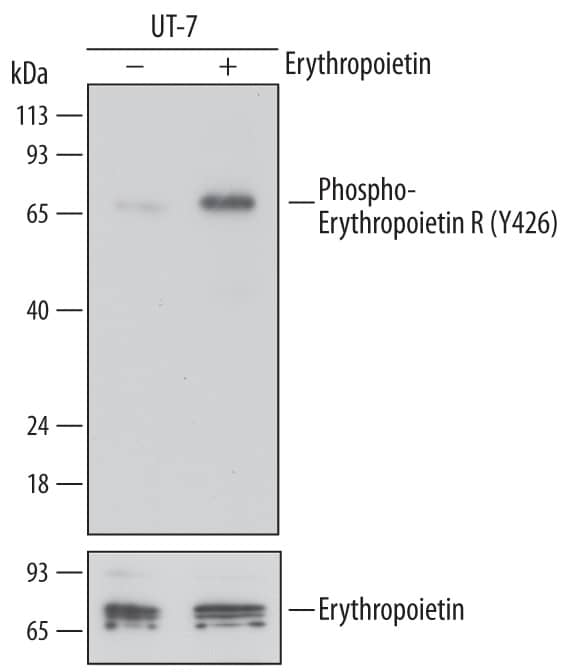Human Phospho-Erythropoietin R (Y426) Antibody
R&D Systems, part of Bio-Techne | Catalog # MAB6926

Key Product Details
Validated by
Biological Validation
Species Reactivity
Human
Applications
Simple Western, Western Blot
Label
Unconjugated
Antibody Source
Monoclonal Mouse IgG1 Clone # 690710
Product Specifications
Immunogen
Phosphopeptide containing the human Erythropoietin R Y426 site
Accession # P19235
Accession # P19235
Specificity
Detects human Phospho-Erythropoietin R (Y426) in direct ELISAs and Western blots.
Clonality
Monoclonal
Host
Mouse
Isotype
IgG1
Scientific Data Images for Human Phospho-Erythropoietin R (Y426) Antibody
Detection of Human Phospho-Erythropoietin R (Y426) by Western Blot.
Western blot shows lysates of UT-7 human acute myeloid leukemia cell line untreated (-) or treated (+) with 300 ng/mL Recombinant Human Erythropoietin (Tissue Culture Grade) (Catalog # 287-TC) for 10 minutes. PVDF membrane was probed with 1 µg/mL of Mouse Anti-Human Phospho-Erythropoietin R (Y426) Monoclonal Antibody (Catalog # MAB6926) followed by HRP-conjugated Anti-Mouse IgG Secondary Antibody (Catalog # HAF007). A specific band was detected for Phospho-Erythropoietin R (Y426) at approximately 64 to 70 kDa (as indicated). For additional reference, the membrane was stripped and reprobed with 1 µg/mL of Mouse Anti-Human Erythropoietin R Monoclonal Antibody (lower panel, Catalog # MAB3072). This experiment was conducted under reducing conditions and using Immunoblot Buffer Group 1.Detection of Human Phospho-Erythropoietin R (Y426) by Simple WesternTM.
Simple Western lane view shows lysates of UT-7 human acute myeloid leukemia cell line untreated (-) or treated (+) with 300 ng/mL Recombinant Human Erythropoietin (Tissue Culture Grade) (Catalog # 287-TC) for 10 minutes, loaded at 0.2 mg/mL. A specific band was detected for Phospho-Erythropoietin R (Y426) at approximately 70 kDa (as indicated) using 10 µg/mL of Mouse Anti-Human Phospho-Erythropoietin R (Y426) Monoclonal Antibody (Catalog # MAB6926). This experiment was conducted under reducing conditions and using the 12-230 kDa separation system.Applications for Human Phospho-Erythropoietin R (Y426) Antibody
Application
Recommended Usage
Simple Western
10 µg/mL
Sample: UT‑7 human acute myeloid leukemia cell line treated with Recombinant Human Erythropoietin (Tissue Culture Grade) (Catalog # 287-TC)
Sample: UT‑7 human acute myeloid leukemia cell line treated with Recombinant Human Erythropoietin (Tissue Culture Grade) (Catalog # 287-TC)
Western Blot
1 µg/mL
Sample: UT‑7 human acute myeloid leukemia cell line treated Recombinant Human Erythropoietin (Tissue Culture Grade) (Catalog # 287-TC)
Sample: UT‑7 human acute myeloid leukemia cell line treated Recombinant Human Erythropoietin (Tissue Culture Grade) (Catalog # 287-TC)
Formulation, Preparation, and Storage
Purification
Protein A or G purified from hybridoma culture supernatant
Reconstitution
Sterile PBS to a final concentration of 0.5 mg/mL. For liquid material, refer to CoA for concentration.
Formulation
Lyophilized from a 0.2 μm filtered solution in PBS with Trehalose. *Small pack size (SP) is supplied either lyophilized or as a 0.2 µm filtered solution in PBS.
Shipping
Lyophilized product is shipped at ambient temperature. Liquid small pack size (-SP) is shipped with polar packs. Upon receipt, store immediately at the temperature recommended below.
Stability & Storage
Use a manual defrost freezer and avoid repeated freeze-thaw cycles.
- 12 months from date of receipt, -20 to -70 °C as supplied.
- 1 month, 2 to 8 °C under sterile conditions after reconstitution.
- 6 months, -20 to -70 °C under sterile conditions after reconstitution.
Background: Erythropoietin R
References
- Spivak, J.L. (2001) in Cytokine Reference, Oppenhiem, J.J. and M. Feldmann, eds. Academic Press, New York, p. 941.
- Kuramochi, S., Y. Ikawa and K. Todokoro (1990) J. Mol. Biol. 216:567.
- Baynes, R.D. et al. (1993) Blood 82:2088.
Long Name
Erythropoietin Receptor
Alternate Names
EpoR
Gene Symbol
EPOR
UniProt
Additional Erythropoietin R Products
Product Documents for Human Phospho-Erythropoietin R (Y426) Antibody
Product Specific Notices for Human Phospho-Erythropoietin R (Y426) Antibody
For research use only
